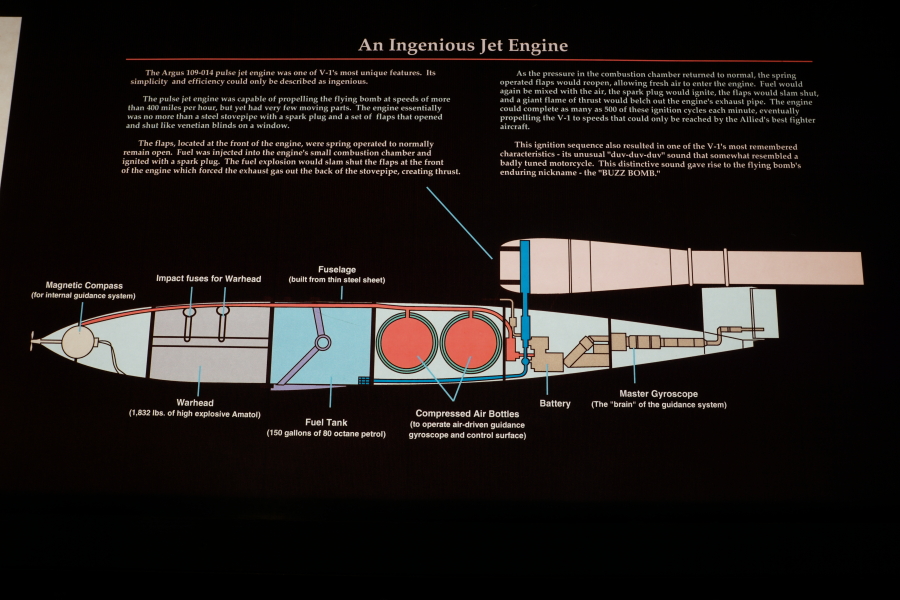| Prev |
heroicrelics.org Kansas Cosmosphere Site Index V-1 Gallery |
Next |
dscc5363.jpg
One of the signs accompanying the buzz bomb. It reads
An Ingenious Jet Engine
The Argus 109-014 pulse jet engine was one of the V-1's most unique features. It simplicity and efficiency could only be described as ingenious.
The pulse jet was capable of propelling the flying bomb at speeds of more than 400 miles per hour, but yet had very few moving parts. The engine essentially was no more than a steel stovepipe with a spark plug and a set of flaps that opened and shut like venetian blinds on a window.
The flaps, located at the front of the engine, were spring operated to normally remain open. Fuel was injected into the engine's small combustion chamber and ignited with a spark plug. The fuel explosion would slam shut the flaps at the front of the engine which forced the exhaust gas out the back of the stovepipe, creating thrust.
As the pressure in the combustion chamber returned to normal, the spring operated flaps would reopen, allowing fresh air to enter the engine. Fuel would again be mixed with the air, the spark plug would ignite, the flaps would slam shut, and a giant flame of thrust would belch out the engine's exhaust pipe. The engine would complete as many as 500 of these ignition cycles each minute, eventually propelling the V-1 to speeds that could only be reached by the Allies' best fighter aircraft.
This ignition sequence also resulted in one of the V-1's most remembered characteristics - its unusual "duv-duv-duv" sound that somewhat resembled a badly-tuned motorcycle. This distinctive sound gave rise to the flying bomb's enduring nickname - the "BUZZ BOMB."
Callouts on the cut-away diagram include
-
Magnetic Compass
(for internal guidance system) - Impact fuses for Warhead
-
Fuselage
(built from thin steel sheet) -
Warhead
(1,832 lbs. of high explosive Amatol) -
Fuel Tank
(150 gallons of 80 octane petrol) -
Compressed Air Bottles
(to operate air-driven guidance gyroscope and control surfaces) - Battery
-
Master Gyroscope
(the "brain" of the guidance system)

| Time picture taken | Thu Apr 14 11:14:22 2016 |
| Location picture taken |
German Gallery Space Hall Kansas Cosmosphere Hutchinson, KS |
| Prev |
heroicrelics.org Kansas Cosmosphere Site Index V-1 Gallery |
Next |